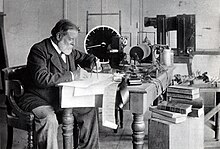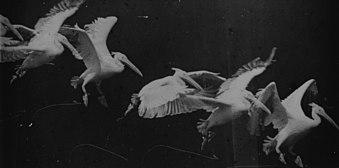User:Marina1711/Photographic rifle

The photographic rifle or chronophotograph is one of the photographic camera ancestors. It was invented by Étienne-Jules Marey in 1882, a scientist and French cronophotograph. It was able to shoot 12 images per second. It was the first invention that catched moving images on the same cronomatographic plate, using a mechanical shutter.
History
[edit]
Étienne-Jules Marey invented it in 1882, based on the Photographic Revolver that the French astronomer Jules Janssen had invented in 1874. He invented it because he wanted to study the different phases of the sun and the movements of Venus. Marey, on the other hand, wanted it to study how animals, insects and birds moved. He tried to use the rifle to study bigger beings like horses or people, but the images were superposed on the film: the slowness of the bigger animals did not give time, between photography and photography, for the subject to separate enough from their previous position and they appeared too close together and overlapping.
Thin invention inspired Auguste and Louis Lumière to create the cinematograph.
Operation
[edit]The operation of a photographic rifle is very similar to a normal rifle, with grip, cannon and rotating drum, except that it does not carry bullets, but photographic plates with which it caught the light at high speed. It worked like this: the hammer was pushed back to the end, movement that allowed the drum to move, where the photographic plates were placed. There was also a shutter on the drum, which prevented the light from entering when the photo was not being taken, and there was a lens in the rifle's cannon. If you wanted to change the focus, the length of the weapon's cannon had to be replaced.[1]
Use
[edit]
Marey was a doctor and was interested in the body movement, which was still not well studied at the time. With the photographic rifle, he pointed to the action he was interested in investigating and shoot once, which got 12 images per second. The machine, thanks to the circular movement of the drum, animated by clockwork mechanisms, could reach a shutter speed of 1/700 seconds. This speed was caused by the discovery of new chemical substances, which were increasingly sensitive to light. Then, when the images were revealed, they were printed on a glass prepared with a gelatinous bromide dissolution and they were all together in the same photograph. In this way, he had a sequence of images in which the movement that was interested in studying was depicted, showing details never seen in the movement of people and animals. From this method of taking photographs, he called Cronofotografia.
.
.[2]
.[2]
External Links
[edit][[Category:History of photography]]
